Twelve sights in Batanes you shouldn't miss
Everywhere in Batanes is a pretty picture. Oddly enough, postcards
aren't popular in the northernmost part of the Philippines. But then
everyone who visits is prepared with a camera - whether it's a bulky
professional SLR or a simple phone camera. It doesn't matter much what
you’ve got, because Batanes is that beautiful.
Here are twelve sights you'd be sorry to miss.
1. Marlboro hills
The famous hills were all our tour guides could talk about on our first day in Batanes. Whenever we'd gush over the view, they would say "Wait 'til you see the Marlboro hills!" I wondered what could be so special about the Marlboro hills. I mean, hills are hills, aren't they? Would there be a Marlboro man emerging from a river?
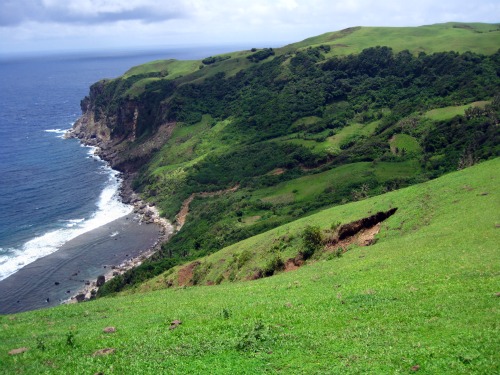
When we finally got to Racuh A Payaman (big pasture), there was no Marlboro man. But there were wild animals, and as promised, a spectacular view -- which unavoidably makes you hum the Marlboro theme. From the hills, you can see what remains of the Old Loran Station, a former US navigational facility.
2. Naidi hills
"Look Simba. Everything the light touches is our kingdom," I couldn't resist saying. We were at the viewing deck on the fifth floor of the lighthouse on Naidi Hill, not far from Basco town proper. The 6-storey building sits next to an Ivatan house, where tourists can buy souvenirs after enjoying the breeze and the view.
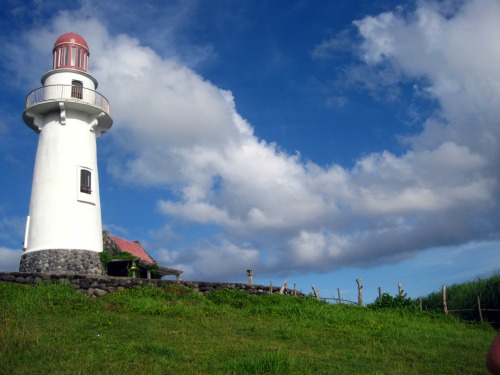
The lighthouse is a good spot to view Batan island from end to end. On a clear day you can also see Sabtang island to the south and Itbayat to the north.
3. House of Dakay
The oldest house in Batanes was built in 1887. It remains standing in Ivana, where Lola Florestida Estrella lives. Built by her grandfather Jose Dacay, the house is a maytuab, meaning it has a four-sloped roof. Like other traditional Ivatan houses, its walls are made of stone and limestone.
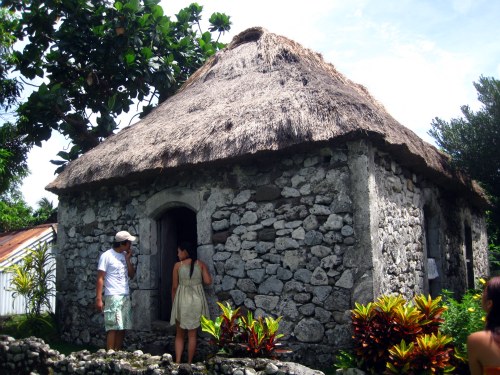
The other type of house in Batanes is a sinadumparan - meaning it has a two-sloped roof made of cogon. The cogon roof can last for three decades with minimal repair.
Typically, the houses are divided into three sections: the rakuh or main room includes the living room and bedroom, there’s a kusina which is course the kitchen, and also a rahawung or storage shed.
4. Diura fishing village
East of Mahatao town proper, the village faces the Pacific Ocean. If you're lucky enough to meet a fisherman, you may get treated to a meal of freshly caught fish.
Diura is most commonly associated with dorado (dolphin fish), which can be found on every hut's roof, drying in the sun. Dorado cannot be bought here because the village is engaged in communal fishing. That means everyone helps, and everyone gets to eat.
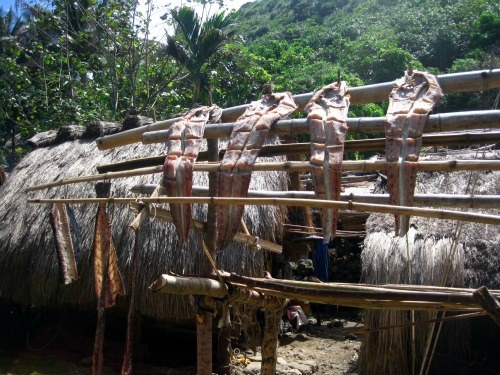
This Ivatan way of using the cooperative system is found not just in Diura but all over Batanes. In general, it is called payuhuan or kayvayvanan, which literally means friendship. For fishing, they call it mataw. For building houses, they call it kapanidungan.
5. The fountain of youth
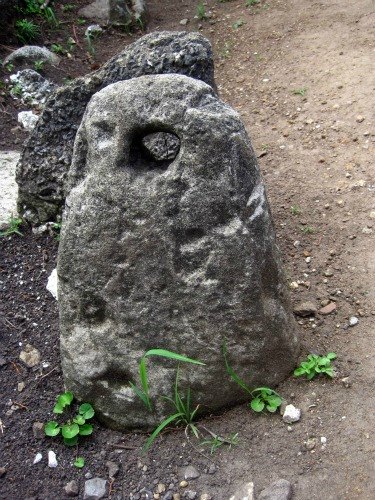 After walking around Diura fishing village, a manmade fountain awaits not-so-weary travelers after a short hike in nearby Racuh a-Idi.
The path cuts through the site of a pre-Hispanic settlement, remnants
of which can still be found in the area. Right by the path are large
stones resembling doughnuts. The poles for the houses would be inserted
in the holes, our guide explained.
After walking around Diura fishing village, a manmade fountain awaits not-so-weary travelers after a short hike in nearby Racuh a-Idi.
The path cuts through the site of a pre-Hispanic settlement, remnants
of which can still be found in the area. Right by the path are large
stones resembling doughnuts. The poles for the houses would be inserted
in the holes, our guide explained.
At the fountain of youth, the water is clear and cold, and there's a large hut where you can enjoy a picnic lunch. The hut is covered with vandalism, but is otherwise clean. There's also a washroom with running water (straight from a pipe; there's no faucet).
Something about the fountain of youth is too artificial, especially compared to the ocean's violent waves and the jagged cliffs that point to the endless sky. But the pool is perfect for escaping the sweltering heat, especially if you're the type that detests sand between the toes.
6. The Mahatao view deck
Tourists will pass by the view deck several times as they go around Batan island. Sometimes, the vehicle simply slows down or stops for a while as you whip out your cameras and try to take the perfect shot. You may think that it's just another picture-perfect spot, but if you actually climb down the steps by the grotto, you'll find yourself in a secluded spot that is serene and violent at the same time.
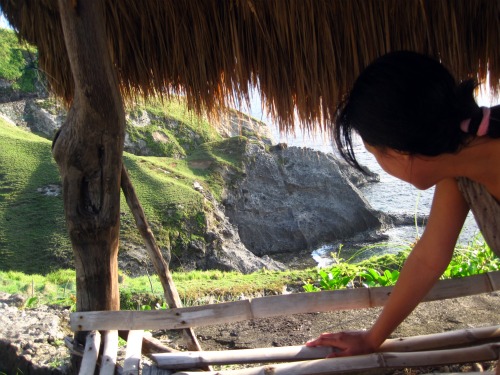
How is this possible? From a safe distance, the waves crashing against the rocks look playful, like it might be fun to sit and let the water wash over you. But beware, because the waves are about as playful as an angry waterfall, which is to say not at all. One moment you're standing, sighing about how beautiful it all is. And then a wave comes and you find yourself crushed against a rock, with at least three scratches.
7. Fundacion Pacita
Once the home studio of artist Pacita Abad, the lodge has since been refurbished by her brother, Budget Secretary Butch Abad. Now a boutique hotel with rooms that resemble galleries, Fundacion Pacita is the most luxurious accommodation on the island. It's also the most expensive, with rooms costing from around five thousand pesos. But part of the proceeds is used to support young Ivatan artists and heritage conservation projects in Batanes, so if you can afford it, it's money well spent. If you can't, you can still visit the charming garden. There is a blue wooden swing set which makes a lovely picture frame.
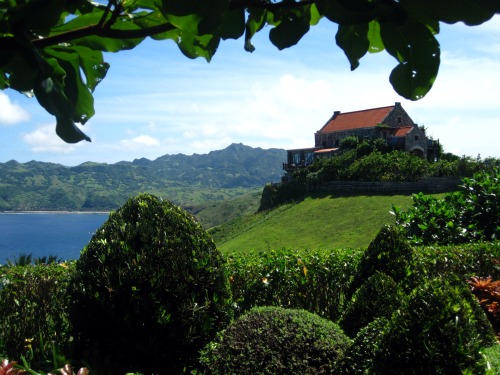
8. Dipnaysupuan Japanese tunnel
The tunnel was built during the Japanese occupation as a shelter for soldiers. Now unoccupied, tourists can go through the series of chambers. There are five doors to the tunnel, a "difficult" route for the adventurous, and an easy one for those who are afraid of the dark. But the difficult route is manageable, and leads back to the road where the tunnel begins.
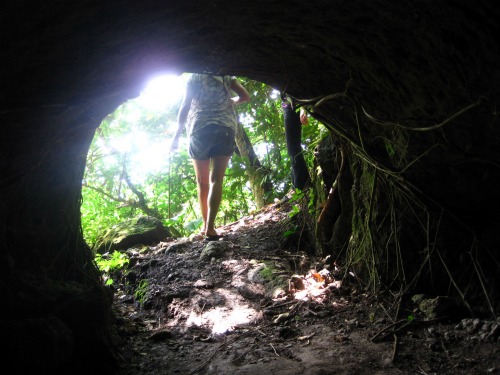
9. Mt. Carmel Chapel
The chapel in Tukon looks like it popped right out of a storybook. Modeled after the traditional Ivatan houses, the chapel has stone walls but instead of cogon, the roof is made of red bricks. On the ceiling, different municipal saints of Batanes are painted by Ivatan artists trained at the Pacita Abad Center for the Arts.
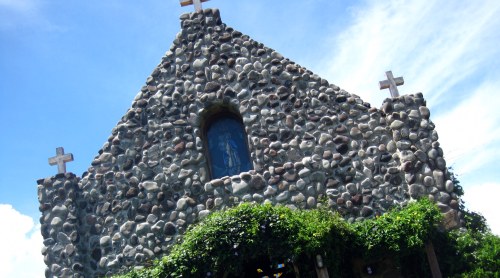
Our guide enthusiastically told us that the chapel is popular for weddings. Light purple flowers float like gauze around the walls, and from the chapel, hills roll down toward the sea. It's not hard to see why couples would want to get married here.
10. Basco PAGASA Station
Not far from the chapel is the PAGASA weather station, where tourists can climb up the tower for an excellent 360-degree view of the island. There's a good view here of the hedgerows, called liveng, which can be made of stones, reeds and trees. The hedgerows are used as windbreakers to protect the crops. They also serve as boundaries between plantation and agricultural crops, or to signify ownership of a particular field.
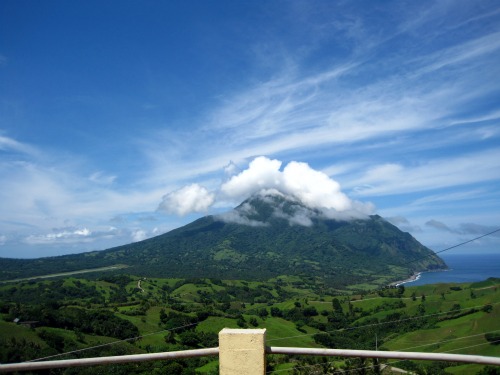
11. Vayang Rolling Hills
Almost as popular as the Marlboro Hills, the Vayang rolling hills have a magical effect. Perhaps it's the fresh air, or the squeaky clean sunshine. It might be the cows grazing contentedly, or the breeze that flutters like a kiss, swirling around your hair and getting it all tangled up, which you don't need to worry about because no one can see you.
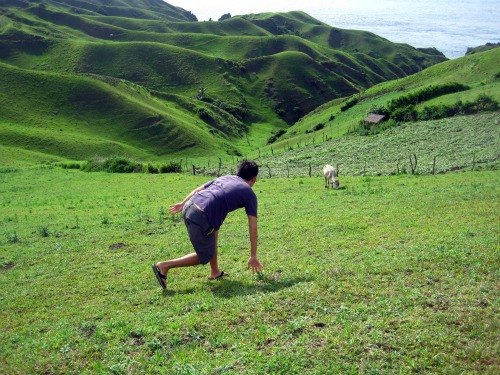
In fact it could be the fact that no one can see you (apart from the cows) that makes people break into song, or do cartwheels, or roll around in the grass. What else is there to do when you're standing on top of a hill, looking at the endless blue and green? You sigh, because you feel infinite and also, infinitely small. And then you look around and wonder if the Von Trapp family will suddenly appear.
12. Valugan Bay
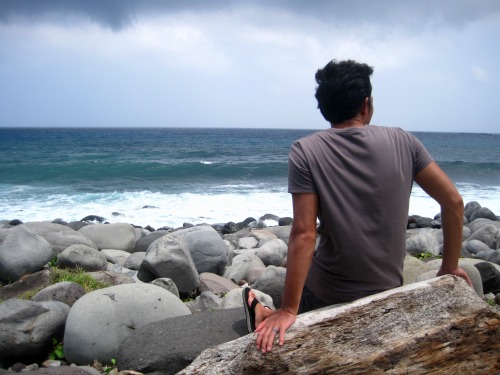
The boulder beach is my favorite spot on Batan island. In 400 AD, Mt. Iraya erupted, leaving enormous rocks along the shore. The rocks are warm and smooth, perfect for an extreme version of hopscotch, or for the more sedentary folk, just sitting and watching the day go by. Like everywhere else in Batanes, the boulder beach is a great spot to take pictures. –
Here are twelve sights you'd be sorry to miss.
1. Marlboro hills
The famous hills were all our tour guides could talk about on our first day in Batanes. Whenever we'd gush over the view, they would say "Wait 'til you see the Marlboro hills!" I wondered what could be so special about the Marlboro hills. I mean, hills are hills, aren't they? Would there be a Marlboro man emerging from a river?

The spectacular view more than makes up for the lack of a Marlboro man.
When we finally got to Racuh A Payaman (big pasture), there was no Marlboro man. But there were wild animals, and as promised, a spectacular view -- which unavoidably makes you hum the Marlboro theme. From the hills, you can see what remains of the Old Loran Station, a former US navigational facility.
2. Naidi hills
"Look Simba. Everything the light touches is our kingdom," I couldn't resist saying. We were at the viewing deck on the fifth floor of the lighthouse on Naidi Hill, not far from Basco town proper. The 6-storey building sits next to an Ivatan house, where tourists can buy souvenirs after enjoying the breeze and the view.

The picture-perfect lighthouse.
The lighthouse is a good spot to view Batan island from end to end. On a clear day you can also see Sabtang island to the south and Itbayat to the north.
3. House of Dakay
The oldest house in Batanes was built in 1887. It remains standing in Ivana, where Lola Florestida Estrella lives. Built by her grandfather Jose Dacay, the house is a maytuab, meaning it has a four-sloped roof. Like other traditional Ivatan houses, its walls are made of stone and limestone.

Lola Florestida's house is the most-visited abode on the island.
The other type of house in Batanes is a sinadumparan - meaning it has a two-sloped roof made of cogon. The cogon roof can last for three decades with minimal repair.
Typically, the houses are divided into three sections: the rakuh or main room includes the living room and bedroom, there’s a kusina which is course the kitchen, and also a rahawung or storage shed.
4. Diura fishing village
East of Mahatao town proper, the village faces the Pacific Ocean. If you're lucky enough to meet a fisherman, you may get treated to a meal of freshly caught fish.
Diura is most commonly associated with dorado (dolphin fish), which can be found on every hut's roof, drying in the sun. Dorado cannot be bought here because the village is engaged in communal fishing. That means everyone helps, and everyone gets to eat.

Everyone gets to eat, thanks to the miracle of kayvayvanan.
This Ivatan way of using the cooperative system is found not just in Diura but all over Batanes. In general, it is called payuhuan or kayvayvanan, which literally means friendship. For fishing, they call it mataw. For building houses, they call it kapanidungan.
5. The fountain of youth

What remains of a pre-Hispanic settlement.
At the fountain of youth, the water is clear and cold, and there's a large hut where you can enjoy a picnic lunch. The hut is covered with vandalism, but is otherwise clean. There's also a washroom with running water (straight from a pipe; there's no faucet).
Something about the fountain of youth is too artificial, especially compared to the ocean's violent waves and the jagged cliffs that point to the endless sky. But the pool is perfect for escaping the sweltering heat, especially if you're the type that detests sand between the toes.
6. The Mahatao view deck
Tourists will pass by the view deck several times as they go around Batan island. Sometimes, the vehicle simply slows down or stops for a while as you whip out your cameras and try to take the perfect shot. You may think that it's just another picture-perfect spot, but if you actually climb down the steps by the grotto, you'll find yourself in a secluded spot that is serene and violent at the same time.

It's beautiful until you get crushed against a rock.
How is this possible? From a safe distance, the waves crashing against the rocks look playful, like it might be fun to sit and let the water wash over you. But beware, because the waves are about as playful as an angry waterfall, which is to say not at all. One moment you're standing, sighing about how beautiful it all is. And then a wave comes and you find yourself crushed against a rock, with at least three scratches.
7. Fundacion Pacita
Once the home studio of artist Pacita Abad, the lodge has since been refurbished by her brother, Budget Secretary Butch Abad. Now a boutique hotel with rooms that resemble galleries, Fundacion Pacita is the most luxurious accommodation on the island. It's also the most expensive, with rooms costing from around five thousand pesos. But part of the proceeds is used to support young Ivatan artists and heritage conservation projects in Batanes, so if you can afford it, it's money well spent. If you can't, you can still visit the charming garden. There is a blue wooden swing set which makes a lovely picture frame.

Staying at Fundacion Pacita is expensive, but picture-taking is free.
8. Dipnaysupuan Japanese tunnel
The tunnel was built during the Japanese occupation as a shelter for soldiers. Now unoccupied, tourists can go through the series of chambers. There are five doors to the tunnel, a "difficult" route for the adventurous, and an easy one for those who are afraid of the dark. But the difficult route is manageable, and leads back to the road where the tunnel begins.

The light at the end of the cold, damp, and dark tunnel.
9. Mt. Carmel Chapel
The chapel in Tukon looks like it popped right out of a storybook. Modeled after the traditional Ivatan houses, the chapel has stone walls but instead of cogon, the roof is made of red bricks. On the ceiling, different municipal saints of Batanes are painted by Ivatan artists trained at the Pacita Abad Center for the Arts.

The chapel is perfect for a fairy tale wedding.
Our guide enthusiastically told us that the chapel is popular for weddings. Light purple flowers float like gauze around the walls, and from the chapel, hills roll down toward the sea. It's not hard to see why couples would want to get married here.
10. Basco PAGASA Station
Not far from the chapel is the PAGASA weather station, where tourists can climb up the tower for an excellent 360-degree view of the island. There's a good view here of the hedgerows, called liveng, which can be made of stones, reeds and trees. The hedgerows are used as windbreakers to protect the crops. They also serve as boundaries between plantation and agricultural crops, or to signify ownership of a particular field.

The PAGASA tower offers an excellent 360-degree view of the island.
11. Vayang Rolling Hills
Almost as popular as the Marlboro Hills, the Vayang rolling hills have a magical effect. Perhaps it's the fresh air, or the squeaky clean sunshine. It might be the cows grazing contentedly, or the breeze that flutters like a kiss, swirling around your hair and getting it all tangled up, which you don't need to worry about because no one can see you.

Something about the hills brings out the inner child in everyone.
In fact it could be the fact that no one can see you (apart from the cows) that makes people break into song, or do cartwheels, or roll around in the grass. What else is there to do when you're standing on top of a hill, looking at the endless blue and green? You sigh, because you feel infinite and also, infinitely small. And then you look around and wonder if the Von Trapp family will suddenly appear.
12. Valugan Bay

The perfect spot to sit and watch the day go by.
The boulder beach is my favorite spot on Batan island. In 400 AD, Mt. Iraya erupted, leaving enormous rocks along the shore. The rocks are warm and smooth, perfect for an extreme version of hopscotch, or for the more sedentary folk, just sitting and watching the day go by. Like everywhere else in Batanes, the boulder beach is a great spot to take pictures. –

No comments:
Post a Comment